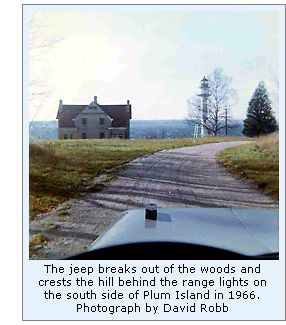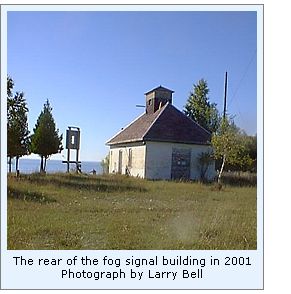|
The Fog Signal The foghorns were another matter. On rainy days and certainly in the fall when the cold air drifts over the summer warmed Green Bay water would generate a dense fog. When it was down to ¼ mile or close to it, we would light them off. I cannot remember the exact procedure but I recall I had to open a pressure valve and then the signal would cycle every minute on the minute with a one second blast, one second of silence and then a one second blast followed by 58 seconds of glorious silence. The original horn (s) were replaced in the late fifties with modern diaphones that carried sound further and penetrated the fog better. They were also a lot louder. I first heard them while lying in my rack across the island at about 2:00 am in the morning. It kept me awake most of the night. That was then. If I would hear them tonight, I would sleep like a baby held in its mother's arms. Oh, it was loud all right. It was right over your head and bolted to the roof you were sitting under. It would shake the whole building. You couldn't talk to a person right next to you when they went off. You learned to unconsciously time your sentences when speaking with another person. Sometimes, it would go on for days.
Those long night watches and solitude day watches were just the thing for this man at his ripe old age of 21. I had basically a year to think. Just think! I used to have long conversations with myself. We'd (I and I) talk about everything - out loud. They were good conversations, too. I enjoyed them because they were with some one who was my intellectual equal and always agreed with my reason. I thought I was the only one who talked to himself until I interrupted a conversation with the Farr twins. To this day, I have no problem dealing with being alone. Not everyone can because they eventually find that they don't like themselves. It is a tough thing to face the real you when you have no other distractions and you can't hide your true personality and character behind false images and trappings. It's just you and you cannot deceive "you". Anyway, I liked it and today when I am caught up in the scurry and stress of the business world, the thought of that little watch shack becomes very appealing. The Range Lights Let's talk about the Rear Range Light. That's the taller one that everyone photographs. The front light is merely a white wood billboard with a bright red light on it that sits about 8 feet off the ground. The Rear Range Light is made entirely of steel. It sits on a concrete foundation that was dug through the surface gravel until they met bedrock but a few feet down. Again, it has been a long time since I was in the light and at that, I was only in it once to wash the windows and polish the lens. Its height is approximately 80 feet from the base too the beam line. It is essentially a smooth culvert drainpipe sitting on end of about 8 feet in diameter. It is entered through a steel door at the back of its base. Inside, it is an unglamorous steel tube with a steel spiral staircase that winds it's way to a trap door at the level of the first balcony. This compartment was vacant when I was there and had one small door facing the straight that led to the lookout balcony below the light platform. The balcony is about 2 ½ feet wide. There are no windows or ports in the base of the light that I remember. From the inside of the first balcony, there is another short ¼ turn spiral staircase the enters again through a trap door to the house containing the marvelous brass and crystal fourth order Fresnel lens. One must move around the light mechanism sideways to fit between the large windows and the imposing lens. The mechanism and the vented Fresnel lens stand about three feet tall on a welded steel pedestal in the middle of the cramped space. At first glance, it appears to be a glass beehive because of its similar shape. The lens is actually hundreds of three sided high quality glass prisms that are mounted one above the other with space between on a gleaming heavy brass frame. It is divided into quadrants with one of them opening for service. Actually, the whole lens could be dismantled, prism by prism but it would be a job worse than reassembling your grandfather's pocket watch to get all of the prisms back precisely in place. Each prism was cut uniquely for its position on the lamp structure to redirect the direction of the light. They are not only beautiful but delicate if not fragile. On a sunny day, the light mechanism is no less than beautiful. My first impression of it was that alive. As I moved around it, the color spectrums danced across its face giving it an animated illusion. I have never been able to accurately describe my feelings when around a Fresnel lens but I have had some of the same sensations in a large cathedral. They are truly remarkable works of art and we place them in the most dangerous and inhospitable locations in the world.
When I was there, the generators powered the light. Now that the light is vacated, I am sure that it is driven by batteries similar to 6-volt car batteries except that they would be using the deep cycling type to preserve the energy the longest. And to maximize the amount of energy the batteries put out, they would be placed in the lower balcony area after being carried up the 86 steps by hand. This would minimize the loss due to resistance of sending the juice up a long cable. In addition, there are probably some solar panels nearby to extend the working life of the batteries. It is just common sense. The light shines fixed red. When approaching the Port de Morts Passage from Lake Michigan, you sail north while watching the two red range lights on the island off to your port (left). At first, the taller one appears to be left of the lower one. When one is above the other. It is safe to come left and transit the straight. When viewing the rear range light, it actually appears to be white and surrounded by an intensely red corona. The lower Front Range light shines with lesser intensity like that of an automobile's headlamp and shines only over a divided sector. The rest of the real light structure has an angle bar structure to help support it. I had to paint it all that year and hated doing the angle bars. It would have been so much easier to paint if it was a conventionally designed light without supports. However, it was explained to me that the rear range light was one of the newer lights on the Great Lakes, was relatively inexpensive to construct, is extraordinarily strong and benefits from more modern engineering concepts. The fact that a seaman 1st class (me) spent endless hours in a cold wind painting every damn nook and cranny of the endless structure with a one inch sash tool while swinging precariously thirty feet above the ground from a 1 inch hemp rope boson's chair, never entered the equation. (There! Finally got that off my chest.) To a mariner, lighthouses are old friends. They point the way home. When you are in hell's throws of a storm unable to see your hand in front of your face, gut aching and muscle sore from hours of pounding waves and sea sickness, a light appears from the dark and you are suddenly connected. No matter how tired you are, how sick you are, how many times you have sworn never to return to the sea again, you are instantly revitalized at its sight with the nourishment of not just hope but the promise of another day. For this probable reason, lights are romantic. These tall, sentinels of safety, these beckoning symbols of refuge and loneliness stir an element of our human core that cannot be denied. To have once been a lighthouse keeper after all the lighthouse keepers were gone is a uniquely treasured experience.
|
 I'll take a moment now to explain one of
the interesting things about the relationship between the foghorns and the
radio beacons. They both actuated at precisely the same instant. The radio
beacon would send a unique Morse code signal identifying us just as the
horn sent its first blast. If you were somewhere west of Pilot Island for
example, you would hear the radio beacon code instantly over your radio
that was tuned to the correct frequency. The fog signal tone would arrive
at some moments after that. The time differential between them computed at
1080 feet per second would tell you how far away from the fog signal you
were. Beacons and horns commenced at different times around the lakes. If
you heard the signal from Cana Island and Plum Island, you could intersect
two arcs on a chart and get a position that was almost as reliable as a
sight. It was kind of neat for its day.
I'll take a moment now to explain one of
the interesting things about the relationship between the foghorns and the
radio beacons. They both actuated at precisely the same instant. The radio
beacon would send a unique Morse code signal identifying us just as the
horn sent its first blast. If you were somewhere west of Pilot Island for
example, you would hear the radio beacon code instantly over your radio
that was tuned to the correct frequency. The fog signal tone would arrive
at some moments after that. The time differential between them computed at
1080 feet per second would tell you how far away from the fog signal you
were. Beacons and horns commenced at different times around the lakes. If
you heard the signal from Cana Island and Plum Island, you could intersect
two arcs on a chart and get a position that was almost as reliable as a
sight. It was kind of neat for its day. As I said, access to the working
mechanism is through a quadrant that is hung on brass hinges. One opens it
carefully. Inside, I was amazed to find that the power beacon was
illuminated by a clear GE 100-watt light bulb of no particular uniqueness
and available at your local hardware store. There are actually 4 bulbs
that sit in a vertical carousel (Ferris Wheel). When one lamp goes out,
the carousel rotates automatically and 2 seconds later, the next bulb is
burning brightly. This continues until all 4 bulbs are burned out and they
are changed. The Coast Guard pays civilian specialists to service these
mechanisms. Not even the most holy Electricians Mates can work on them.
As I said, access to the working
mechanism is through a quadrant that is hung on brass hinges. One opens it
carefully. Inside, I was amazed to find that the power beacon was
illuminated by a clear GE 100-watt light bulb of no particular uniqueness
and available at your local hardware store. There are actually 4 bulbs
that sit in a vertical carousel (Ferris Wheel). When one lamp goes out,
the carousel rotates automatically and 2 seconds later, the next bulb is
burning brightly. This continues until all 4 bulbs are burned out and they
are changed. The Coast Guard pays civilian specialists to service these
mechanisms. Not even the most holy Electricians Mates can work on them.